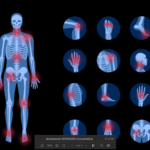Moving Forward
“The study findings have implications for earlier recognition of [RA] in routine clinical practice, particularly for patients with more insidious or milder disease activity at the onset of RA,” Dr. Pope says. “Patients with palindromic rheumatism should be followed by rheumatologists, [because] some will definitely develop [RA]. They can present their [RA] with less swollen joints at onset, but they are more likely to be seropositive.”
Dr. Pope also cautions that early RA can be missed if patients first present between attacks. Early diagnosis of RA is key. “The earlier we diagnose and treat [RA], the more likely patients will go into remission,” she says. Dr. Pope points out that the modern use of cell phone cameras can sometimes provide confirmation of previously swollen joints, which may be helpful in diagnosis.
Moving forward, Dr. Pope thinks it may be helpful to standardize the definition of palindromic rheumatism for better insights when comparing research findings. She believes it may also be revealing to follow patients with palindromic rheumatism and identify potential predictors of ultimate transformation to RA. Theoretically, such biomarkers may allow intervention at early stages to help prevent RA development.
“We are not there yet, but biomarkers could be studied,” Dr. Pope says. “We would need prospective clinical trials to see whether more aggressive interventions, earlier on, may help prevent development of [RA] in some patients with palindromic rheumatism.”
Ruth Jessen Hickman, MD, is a graduate of the Indiana University School of Medicine. She is a freelance medical and science writer living in Bloomington, Ind.
References
- Ellingwood L, Schieir O, Valois MF. Palindromic rheumatism frequently precedes early rheumatoid arthritis: Results from an incident cohort. ACR Open Rheumatology. 2019;0(0):1–6.
- Hannonen P, Möttönen T, Oka M. Palindromic rheumatism. A clinical survey of sixty patients. Scand J Rheumatol. 1987;16(6):413–420.
- Kaushik P. Palindromic rheumatism: A descriptive report of seven cases from North Dakota and a short review of literature. Clin Rheumatol. 2010 Jan;29(1):83–86.
- Powell A, Davis P, Jones N, et al. Palindromic rheumatism is a common disease: Comparison of new‐onset palindromic rheumatism compared to new‐onset rheumatoid arthritis in a two‐year cohort of patients. J Rheumatol. 2008 Jun;35(6):992–994.
- Cabrera-Villalba S, Sanmartí R. Palindromic rheumatism: A reappraisal. Int. J. Clin. Rheumatol. 2013; 8(5): 569–577.
- Gonzalez-Lopez L, Gamez-Nava JI, Jhangri GS, et al. Prognostic factors for the development of rheumatoid arthritis and other connective tissue diseases in patients with palindromic rheumatism. J Rheumatol. 1999 Mar;26(3):540–545.
- Emad Y, Anbar A, Abo-Elyoun I, et al. In palindromic rheumatism, hand joint involvement and positive anti-CCP antibodies predict RA development after one year of follow-up. Clin Rheumatol. 2014 Jun;33(6):791–797.


